Digital Posters
Brain Stem & Cerebellar Diseases
ISMRM & SMRT Annual Meeting • 15-20 May 2021

| Concurrent 6 | 15:00 - 16:00 |
3006. |
Cerebellar changes in Spinocerebellar Ataxia Type 2 and 12 in comparison with healthy controls
Pankaj pankaj1, S Senthil Kumaran1, and Achal Kumar Srivastava2
1NMR, All India Institute of Medical Sciences, New Delhi, India, 2Neurology, All India Institute of Medical Sciences, New Delhi, India
Spinocerebellar Ataxia (SCA), also known as spinocerebellar degeneration, is a degenerative, progressive and genetic disorder that leads to severe disability. On structural morphometrics of isolated cerebellum, we observed significant white matter atrophy in the anterior lobe of the SCA type 2 and 12 patients. Cerebellum atrophy of gray matter in both bilateral anterior and posterior cerebellar lobes, Cerebellar Tonsil, Uvula, Inferior Semi-Lunar Lobule, Declive, Red Nucleus and Substania Nigra was observed in SCA2, with respect to healthy controls. SCA2 patients exhibited more atrophy in comparison to SCA12. Atrophy in the cerebellum suggest deficits in motor and cognition in SCA patients.
|
|||
3007. |
Cerebro-cerebellar impact on brain dynamics in a single-subject with cerebellar ataxia
Silvia Maria Marchese1, Fulvia Palesi2,3, Mariagrazia Bruzzone4, Anna Nigri4, Stefano D'Arrigo5, Chiara Pantaleoni5, Claudia AM Gandini Wheeler-Kingshott2,3,6, Egidio D'Angelo2,3, and Paolo Cavallari1
1Human Physiology Section of the DePT, Università degli Studi di Milano, Milano, Italy, 2Department of Brain and Behavioral Science, Università degli Studi di Pavia, Pavia, Italy, 3Brain Connectivity Center Research Department, IRCCS Mondino Foundation, Pavia, Italy, 4Neuroradiology Department, Fondazione IRCCS Istituto Neurologico "C. Besta", Milano, Italy, 5Developmental Neurology Department, Fondazione IRCCS Istituto Neurologico "C. Besta", Milano, Italy, 6Department of Neuroinflammation, UCL Queen Square Institute of Neurology, Faculty of Brain Sciences, University College London, NMR Research Unit, Queen Square MS Centre, London, United Kingdom
The simulation of whole-brain dynamics in a single-subject affected by Joubert syndrome (non-progressive pediatric cerebellar ataxia), allowed us to investigate the impact of cerebro-cerebellar connectivity in a brain network with cerebellar dysfunction. The prediction power resulted strongly disturbed with the exclusion of the cerebro-cerebellar network from the generation of cerebral activity. These preliminary results suggest that compensatory mechanisms and plasticity must have taken place in the damaged cerebellum itself to support whole brain functional dynamics.
|
|||
3008.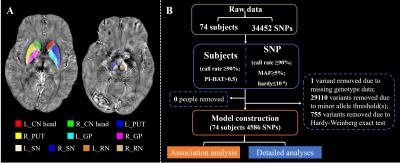 |
Genetic impacts on nigral iron deposition in Parkinson’s disease
Jing jing Wu1, Xiao jun Guan2, Tao Guo2, Cheng Zhou2, Ting Gao3, Xue qin Bai2, Xiao cao Liu3, Lu yan Gu3, Pei yu Huang3, Xiao jun Xu3, and Min ming Zhang2
1Department of Radiology, The Second Affiliated Hospital, Zhejiang University School of Medicine, HangZhou, China, 2Department of Radiology, The Second Affiliated Hospital, Zhejiang University School of Medicine, Hangzhou, China, 3The Second Affiliated Hospital, Zhejiang University School of Medicine, Hangzhou, China
The dysfunction of iron metabolism, especially in substantia nigra (SN), in Parkinson’s disease (PD) has been widely acknowledged, but the genetic influence on iron deposition remains largely unknown. Thus, this study aimed to explore the potential genetic impacts on iron deposition in PD patients. Using imaging genetics association analysis, this study discovers two variants, rs602201 and rs198440, have a positive impact on nigral iron deposition in PD. Specifically, patients with rs602201 polymorphism are particularly vulnerable to iron deposition in SN.
|
|||
3009.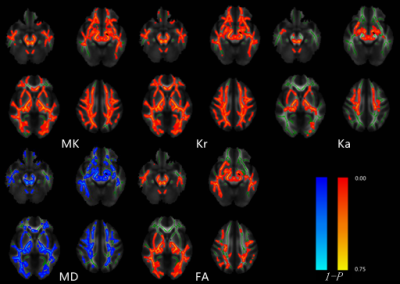 |
The presumed structure alterations of Spinocerebellar Ataxias 3: from presymptomatic to the symptomatic stage
Haishan Qiu1, Jing Zhao1, Manshi Hu1, Mengzhu Wang2, and Jianping Chu1
1Sun Yat-sen University, Guangzhou, China, 2Simens Healthcare, Guangzhou, China
There is an evolving history of structural images with SCA3 patients in different disease stages. The WM damage starts with the impairment of ICP and goes through SCP extends to the midbrain, then widespread to the whole brain. The alteration of GMV does not occur until the arise of ataxia symptom, then began to involve the medulla, cerebellum, and pons, and developed to involve basal ganglion, finally affect the cortical cortex. The impairment of WM tracts precedes the GM atrophy and, irrespective of the patients with or without clinical manifestation, the identified WM damage was significantly correlated with SARA.
|
|||
3010.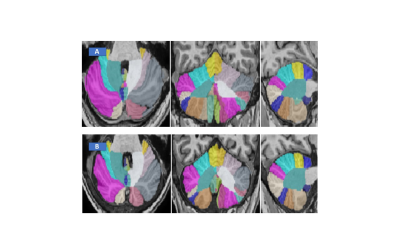 |
Volumetric estimation of various brain parts in Gluten Ataxia patients: A quantitative MRI study
Uma Sharma1, Vishwa Rawat1, Prasenjit Das 2, Achal Kumar Srivastava3, and Govind Makharia4
1Nuclear Magnetic Resonance and MRI Facility, All India Institute of Medical Sciences, New Delhi, India, 2Pathology, All India Institute of Medical Sciences, New Delhi, India, 3Neurology, All India Institute of Medical Sciences, New Delhi, India, 4Gasteroenterology and Human Nutrition, All India Institute of Medical Sciences, New Delhi, India
Present study investigated volumetric volume changes in the brain of patients suffering from Gluten Ataxia (GA) using MRI. GA patients were seen to have significantly low brain and cerebellar volumes along the lobules which form the part of vermis suggesting cell degeneration and role of vermis in GA. GA patients also had significantly high levels of CSF. No significant changes were observed in whole brain grey matter, cerebrum, caudate, hippocampus and amygdala. Our results suggest that cerebrum volume is not linked to GA but lobes of cerebellum, whole brain white matter and CSF is significantly associated with GA.
|
|||
3011.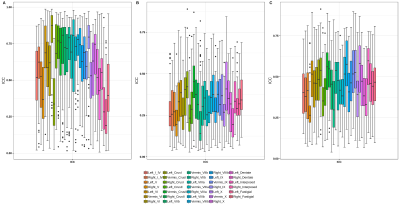 |
Evaluating normative Cerebellum radiomics on FLAIR images
Umang Pandey1, Jitender Saini2, Manoj Kumar2, Rakesh Gupta3, and Madhura Ingalhalika1
1Symbiosis Centre for Medical Image Analysis, Symbiosis International University, Pune, India, 2Department of Radiology, National Institute of Mental Health and Neurosciences, Bengaluru, India, 3Department of Radiology,Fortis Memorial Research Institute, Gurgaon, India
Radiomics in neuroimaging has gained momentum as a noninvasive prediction tool not only to differentiate between types of brain tumors, but also to create phenotypic signatures in neurological/neuropsychiatric disorders. However, there is currently little understating about the robustness and reproducibility of radiomic features in a baseline normative population. Moreover, the radiomics across cerebellum which has a more complex anatomy has not been evaluated This study investigates and demonstrates the intra- and inter-scanner reproducibility and the spatial variations within the regions of the cerebrum and cerebellum. Our findings suggest that care must be taken while interpreting these features for pathological inferences.
|
|||
3012.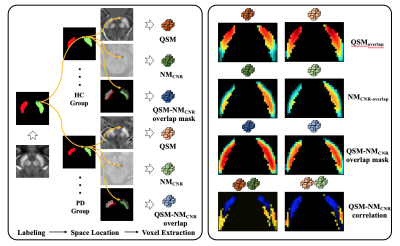 |
Spatial changes of neuromelanin and iron content in substantial nigra pars compacta in early-stage idiopathic Parkinson’s disease
Zenghui Cheng1, Bin Xiao2, Naying He3, Dinggang Shen4, Qian Wang5, Feng Shi4, Youmin Zhang3, Pei Huang3, Yan Li3, Sean K Sethi6, Kiarash Ghassaban7, Shengdi Chen3, Fuhua Yan3, and Ewart Mark Haacke7
1Radiology, Ruijin Hospital, Shanghai Jiao Tong University School of Medicine, Shanghai, China, 2Medical Imaging Technology, 、School of Biomedical Engineering, Shanghai Jiao Tong University, Shanghai, China, 3Ruijin Hospital, Shanghai Jiao Tong University School of Medicine, Shanghai, China, 4Shanghai United Imaging Intelligence Co., Ltd., Shanghai, China, 5Medical Imaging Technology, School of Biomedical Engineering, Shanghai Jiao Tong University, Shanghai, China, 6Magnetic Resonance Innovations, Inc, Bingham Farms, MI, United States, 7Wayne State University, Detroit, MI, United States
Parkinson’s disease (PD) is a common neurodegenerative disorder characterized by progressive loss of neuromelanin-containing dopaminergic neurons and iron deposition mainly in the substantia nigra (SN). Previous studies mainly focused on global changes in both neuromelanin (NM) and iron content. In this study, we used a voxel-wise analysis to investigate the spatial changes of iron and NM content in PD and found that the ventral and medial part of the SN pars compacta had more iron deposition and less neuromelanin, especially, in early-stage PD.
|
|||
3013.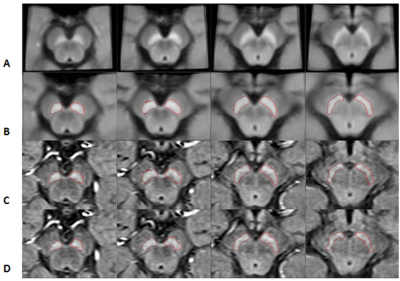 |
Automatic Detection of the Neuromelanin, Substantia Nigra, Red Nucleus and Subthalamic Nucleus using a High Resolution Brain Template
Mojtaba Jokar1, Ying Wang1,2, Zhijia Jin3, Yan Li3, Zenghui Cheng3, Yu Liu3, Naying He3, Fuhua Yan3, and E. Mark Haacke1,2,3,4,5
1Magnetic Resonance Innovations, Inc., Bingham Farms, MI, United States, 2Department of Radiology, Wayne State University, Detroit, MI, United States, 3Department of Radiology, Ruijin Hospital, Shanghai Jiao Tong University School of Medicine, Shanghai, China, 4Department of Biomedical Engineering, Wayne State University, Detroit, MI, United States, 5Department of Neurology, Wayne State University, Detroit, MI, United States
A total of 37 healthy controls (HC) were used to create a template which was then used to automatically detect neuromelanin, substantia nigra, red nucleus and subthalamic nucleus in the midbrain. In order to evaluate the performance of the template, regions of interest (ROIs) were drawn manually on the MTC and QSM images. DICE similarity coefficients and volume ratios of the template to manual data were calculated for different thresholds for each structure. These showed promising results, validating the performance of the template.
|
|||
3014.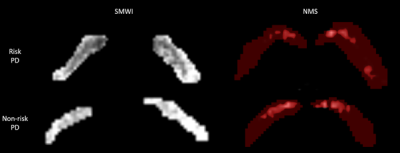 |
Neuromelanin Sensitive MRI and QSM of the Substantia Nigra in Parkinson’s-Linked Asian LRRK2 Carriers
Septian Hartono1,2, An Sen Tan3, Weiling Lee4, Joey Oh4, Kuan Jin Lee5, Jongho Lee6, Eng King Tan1,2, and Ling Ling Chan2,4
1National Neuroscience Institute, Singapore, Singapore, 2Duke-NUS Medical School, Singapore, Singapore, 3Lee Kong Chian School of Medicine, Nanyang Technological University, Singapore, Singapore, 4Singapore General Hospital, Singapore, Singapore, 5Singapore BioImaging Consortium, Singapore, Singapore, 6Seoul National University, Seoul, Korea, Republic of
Asian-specific leucine-rich repeat kinase 2 (LRRK2) gene risk variants are associated with increased risk of idiopathic Parkinson’s disease (PD) and accelerated motor progression in disease. We examined the role of quantitative susceptibility mapping (QSM) and neuromelanin-sensitive MRI (NMS) in quantifying dopaminergic denervation in the substantia nigra (SN) in LRRK2 risk-carriers and non-carriers in PD. QSM susceptibility and high-iron area in the SN were significantly increased in PD risk-carriers compared to non-carriers; NMS showed no difference between these two groups. Combined quantitative QSM models displayed good classification performance discriminating risk-carrier from non-carrier groups (68.4% sensitivity, 92.3% specificity, AUC 0.804) in PD.
|
|||
3015.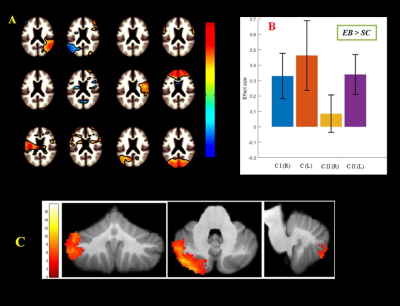 |
Altered cortico-cerebellar functional connectivity of language processing in congenital blind children
A Ankeeta1, S Senthil Kumaran1, and Rohit Saxena2
1Department of NMR & MRI Facility, All India Institute of Medical Sciences, Delhi, India, 2Dr RP Centre of Ophthalmology, All India Institute of Medical Sciences, Delhi, India
This study investigated structural alteration, cerebellar BOLD activation and functional connectivity during Braille reading by congenital blind (CB) children. Functional magnetic resonance imaging (fMRI) during Braille reading and T1 data were acquired on a 3T MR scanner in CB and sighted control (SC) children. CB children showed bilateral activation in posterior lateral cerebellum Crus I, II. BOLD cerebellar, visual signals and functional connectivity measures exhibited positive correlation with duration of Braille reading. Involvement of cerebellum, visual cortex during Braille reading in congenital blind children suggest its role in haptic language processing.
|
|||
3016.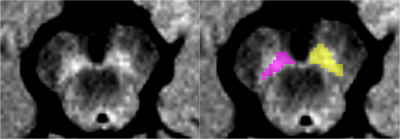 |
Substantia Nigra Neuromelanin-sensitive Imaging Biomarker to Differentiate Between Atypical Parkinsonian Syndromes
Rahul Gaurav1,2,3, Emina Arsovic1,4, Lydia Chougar1,4, Nadya Pyatigorskaya1,2,3,4, Marie Vidailhet2,3,5, and Stephane Lehericy1,2,3,4
1CENIR, ICM Paris, Paris, France, 2Paris Brain Institute (ICM), Sorbonne University, UPMC Univ Paris 06, Inserm U1127, CNRS UMR 7225, Paris, France, 3ICM Team “Movement Investigations and Therapeutics” (MOV’IT), Paris, France, 4Department of Neuroradiology, Pitié-Salpêtrière Hospital, AP-HP, Paris, France, 5Department of Neurology, APHP, Pitié-Salpêtrière Hospital, Paris, France Atypical Parkinsonian disorders are progressive neurodegenerative diseases characterized clinically by parkinsonism, associated with degeneration of dopaminergic neurons in the substantia nigra pars compacta (SNc). Histological studies suggested that dopaminergic cell neurodegeneration pattern may differ between atypical Parkinsonian disorders and with Parkinson’s disease. In this study, we aimed to quantify and compare SNc volume and signal intensity using neuromelanin-sensitive T1-weighted MRI between progressive supranuclear palsy, multiple system atrophy, corticobasal degeneration, dementia with Lewy body and sporadic Parkinson’s disease. |
|||
3017. |
Fibre-specific white matter reduction in patients with multiple system atrophy: comparison of parkinsonian and cerebellar subtypes
Po-Yuan Chen1, Chih-Chien Tsai1, Chin-Song Lu2, Yi-Hsin Weng2, Yi-Ming Wu3, and Jiun-Jie Wang1
1Chang Gung University, Taoyuan, Taiwan, 2Chang Gung Memorial Hospital, Taoyuan, Taoyuan, Taiwan, 3Chang Gung Memorial Hospital, Linkou, Taoyuan, Taiwan
Precise differentiation between MSA subtype is critical in medical intervention and prognosis. The results of previous studies using DTI to differentiate subtypes of MSA is controversial. We use fixel based analysis to examine the tract-specific differences in white matter between individuals with MSA and healthy controls. The results demonstrate the white matter degeneration in specific fibre bundle, including middle cerebellar peduncle, pontine crossing tract and cerebellar white matter tracts in the early MSA-C patients; in contrast, this pattern was not observed in MSA-P patients. This suggests that FBA may be a sensitive marker for early differential diagnosis of MSA subtype.
|
|||
3018.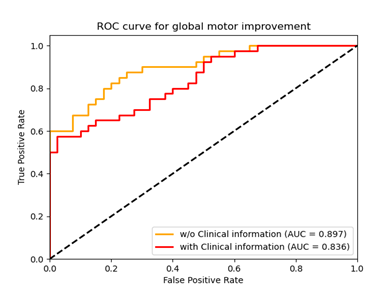 |
Substantia Nigra Susceptibility Features Derived by Radiomics Predict Motor Outcome for STN-DBS in Parkinson’s Disease
Naying He1, Yu Liu1, Bin Xiao2, Junchen Li3, Chencheng Zhang4, Yijie Lai4, Feng Shi5, Dinggang Shen5, Yan Li1, Hongjiang Wei6, Ewart Mark Haacke1,7, Weibo Chen8, Qian Wang2, Dianyou Li4,
and Fuhua Yan1
1Radiology, Ruijin Hospital, Shanghai Jiao Tong University School of Medicine, Shanghai, China, 2Institute for Medical Imaging Technology, School of Biomedical Engineering, Shanghai Jiao Tong University, Shanghai, China, Shanghai, China, 3Changshu Hospital Affiliated to Nanjing University of Chinese Medicine, No. 6 Huanghe Road, Changshu, China, Changshu, China, 4Department of Neurosurgery, Center for Functional Neurosurgery, Ruijin Hospital, Shanghai Jiao Tong University School of Medicine, Shanghai, China, Shanghai, China, 5Shanghai United Imaging Intelligence Co., Ltd., Shanghai, China, Shanghai, China, 6Institute for Medical Imaging Technology, Department of Biomedical Engineering, Shanghai Jiao Tong University, Shanghai, China, Shanghai, China, 7Department of Radiology, Wayne State University, Detroit, Michigan, USA, Detroit, MI, United States, 8Philips Healthcare,Shanghai,China, Shanghai, China
Currently, there are neither individual objective nor quantitative indicators for predicting DBS motor outcome. We hypothesized that the distribution of SN iron changes in PD patients may reflect a specific disease trait and could potentially account for some variability in the motor outcomes after sub-thalamic nucleus (STN) deep brain stimulation (DBS). We developed a radiomics model with machine learning (RA-ML) based on preoperative individual QSM of the SN to predict motor outcome for STN-DBS in PD and it performed best with an AUC of 0.897. In addition, the threshold probability of the RA-ML model can differentiate surgical responders and non-responders.
|
|||
3019.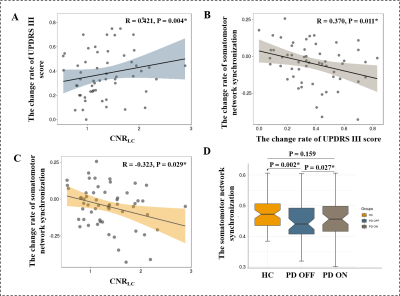 |
Locus coeruleus degeneration associated with less levodopa responsiveness in Parkinson’s Disease
Cheng Zhou1 and Minming Zhang1
1Zhejiang University, Hangzhou, China
We conducted a neuromelanin sensitive magnetic resonance imaging, which is a good indicator for LC integrity, in 57 PD patients. We depicted a significant positive association between LC integrity and motor improvement after levodopa administration. We further confirmed this relationship in the level of objective brain alteration: LC integrity associated with the improvement of somatomotor network synchronization calculated from functional magnetic resonance imaging. We concluded that LC degeneration was an indicator for less levodopa responsiveness. LC integrity evaluation might be an alternative tool in predicting disease prognosis and stratifying patients into clinical trials for improving the efficacy of levodopa.
|
|||
3020.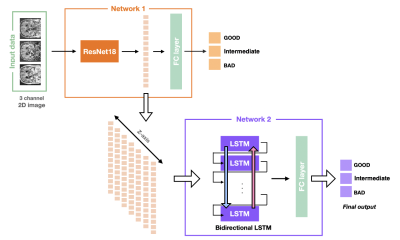 |
Automatic assessment of motion artifact on Nigrosome 1 visualization protocol using CNN-LSTM
Junghwa Kang1, Na Young Shin2, and Yoonho Nam1,2
1Division of Biomedical Engineering, Hankuk University of Foreign Studies, Yongin, South Korea, yongin, Korea, Republic of, 2Seoul St.Mary’s Hospital, Department of Radiology, The Catholic University of Korea, Seoul, South Korea, Seoul, Korea, Republic of
We proposed an automatic evaluation model for estimating the degree of motion artifacts in high-resolution multi-echo gradient echo images for nigrosome-1 visualization in the substantia nigra. A combination of a convolutional neural network and a long short-term memory was used to develop the automatic motion evaluation model. The results demonstrated that the proposed model could be useful tools for N1 visualization for diagnosing Parkinson’s disease.
|
|||
3021. |
Quantitative mapping of substantia nigra iron and neuromelanin in Parkinson’s Disease
Jiahao Li1,2, Kelly Gillen1, Ilhami Kovanlikaya1, Thanh Nguyen1, Alexey Dimov1, Kailyn Li1, Weiyuan Huang1, Xianfu Luo1, Carly Skudin1, Eileen Chang1, Alexander Shtilbans1,3, and Yi Wang1,2
1Weill Cornell Medicine, New York, NY, United States, 2Meinig School of Biomedical Engineering, Cornell University, Ithaca, NY, United States, 3Hospital for Special Surgery, New York, NY, United States
Parkinson’s disease (PD) is a neurodegenerative disorder characterized pathologically by loss of dopaminergic neurons and accumulation of iron in the substantia nigra. Our MR imaging study uses quantitative susceptibility mapping (QSM) and magnetization transfer contrast (MTC) to quantify iron and neuromelanin, respectively in healthy controls, patients with REM sleep behavior disorder (RBD), and PD. We demonstrate that patients with PD have an increase in iron but reduction in neuromelanin in the substantia nigra as compared to healthy controls. Loss of dopaminergic neurons can cause release of neuromelanin, thus furthering a neuroinflammatory and neurodegenerative cycle1.
|
|||
3022.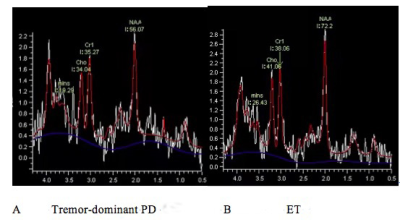 |
Substantia nigra magnetic resonance spectrum in differentiating tremor-dominant Parkinson’s disease from essential tremors
Rushi Chen1, Yan Bai1, Qin Feng1, Menghuan Zhang1, Xianchang Zhang2, and Meiyun Wang1
1Henan provincial people's hospital, Zhengzhou, China, 2MR Collaboration, Siemens Healthcare Ltd, Beijing, China, Beijing, China
Conventional magnetic resonance imaging has limitations in differentiating Parkinson’s disease (PD) from essential tremors (ET). Magnetic resonance spectroscopy (MRS) can non-invasively detect neurochemical alterations in biological tissues. In this study, we used MRS to obtain N-acetylaspartate (NAA)/creatine (Cr) and choline (Cho)/Cr ratios in the substantia nigra (SN) of patients with tremor-dominant PD and ET. The NAA/Cr ratio in the contralateral SN was significantly higher in patients with tremor-dominant PD than those with ET, whereas the Cho/Cr ratios showed no significant differences between groups. The findings suggest that MRS in the SN may be helpful in differentiating tremor-dominant PD from ET.
|
|||
3023.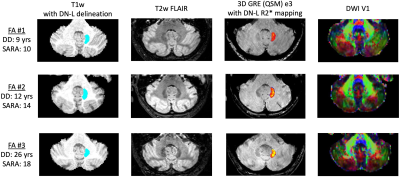 |
Feasibility of a short but comprehensive MRI protocol for quantitative characterization of progressive neurodegeneration in Friedreich ataxia
Koene R.A. Van Dijk1, Courtney A. Bishop2, James O’Callaghan2, James A. Goodman1, Laigao Chen1, Peter T. Loudon3, Lawrence Charnas4, Eugenii A. Rabiner2, and Richard Festenstein5
1Digital Medicine and Translational Imaging, Early Clinical Development, Pfizer, Cambridge, MA, United States, 2Invicro, London, United Kingdom, 3Clinical Sciences, Early Clinical Development, Pfizer, Cambridge, United Kingdom, 4Rare Disease Research Unit, Pfizer, Cambridge, MA, United States, 5Department of Brain Sciences, Imperial Clinical Research Facility and BRC (NIHR), Imperial College London, London, United Kingdom
We report on feasibility of a short but comprehensive 3T brain MRI protocol in Friedreich ataxia. The multi-parametric protocol includes measures of anatomy, iron content, several indices of white matter, and brain metabolites. The scan session, lasting less than 60 minutes, was tolerated well by all 8 patients who had varying degrees of ataxia symptomatology, and provided good quality imaging data for the majority of sequences and patients. This protocol allows non-invasive quantitative characterization of progressive neurodegeneration in cerebral and cerebellar structures in patients with Friedreich ataxia suggesting the potential for rich, longitudinal phenotyping in this population.
|
|||
3024.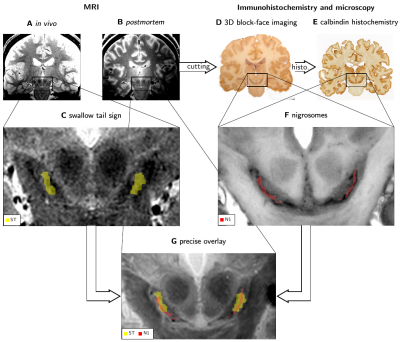 |
Swallow tail sign and nigrosome 1 - close but not quite the same
Malte Brammerloh1,2, Evgeniya Kirilina1,3, Anneke Alkemade4, Pierre-Louis Bazin1,4, Caroline Jantzen1, Carsten Jäger1,5, Andreas Herrler6, Kerrin J. Pine1, Penny Gowland7, Markus Morawski5, Birte Forstmann4, and Nikolaus Weiskopf1,2
1Max Planck Institute for Human Cognitive and Brain Sciences, Leipzig, Germany, 2Faculty of Physics and Earth Sciences, Leipzig University, Leipzig, Germany, 3Center for Cognitive Neuroscience Berlin, Freie Universität Berlin, Berlin, Germany, 4Integrative Model-based Cognitive Neuroscience Research Unit, University of Amsterdam, Amsterdam, Netherlands, 5Paul Flechsig Institute of Brain Research, University of Leipzig, Leipzig, Germany, 6Department of Anatomy and Embryology, Maastricht University, Maastricht, Netherlands, 7Sir Peter Mansfield Imaging Center, University of Nottingham, Nottingham, United Kingdom
MRI holds great promise for diagnosing Parkinson's disease, based on the disappearance of the swallow tail sign in T2*-weighted images, which past research assumed to be nigrosome 1. We studied the sign's anatomical underpinning, combining ultra-high field MRI in vivo and postmortem, 3D-reconstructed microscopy, and immunohistochemistry. Based on block-face images and calbindin-D28K immunohistochemistry, we constructed a 3D nigrosome atlas. We show that nigrosome 1 extends beyond the swallow tail sign by co-registering this atlas to in vivo MRI. As the swallow tail sign only partially overlaps with but is not identical to nigrosome 1, its interpretation needs to be revised.
|
The International Society for Magnetic Resonance in Medicine is accredited by the Accreditation Council for Continuing Medical Education to provide continuing medical education for physicians.